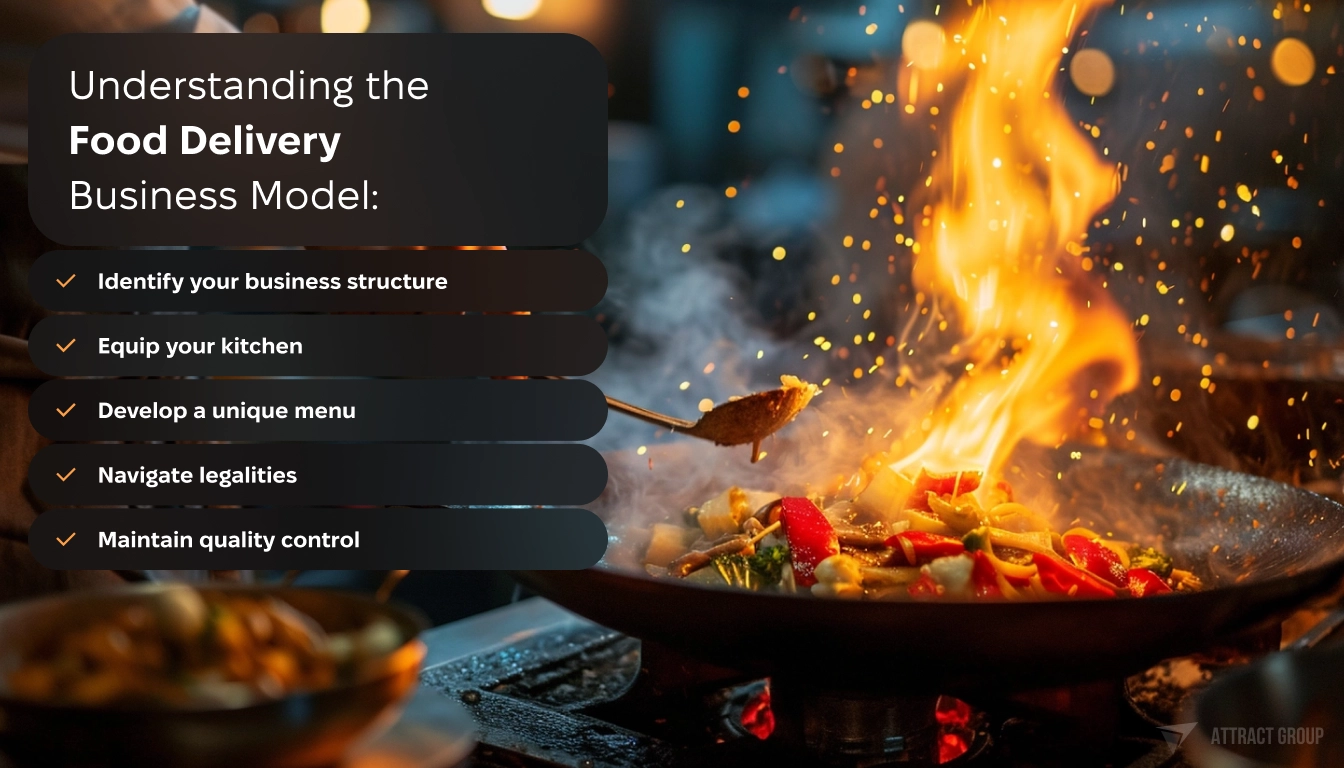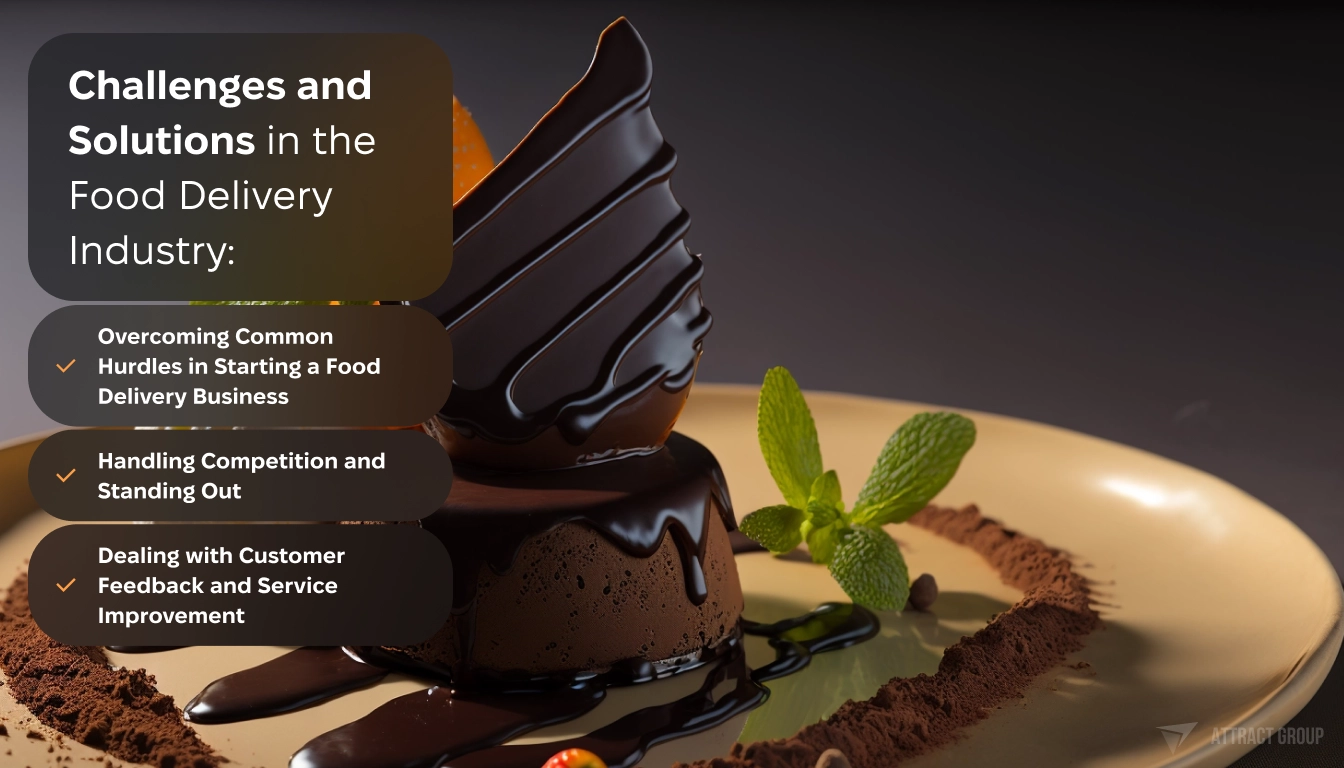A Guide to Starting an Online Food Ordering and Delivery Business: Launching Your Home-Based Food Empire
 16 February 2024
16 February 2024? Listen to the Summary of this article in Audio
The culinary world is ever-changing, and in today’s fast-paced environment, the ability to start a food business from home is not only convenient but also increasingly profitable. With the global food delivery market soaring to remarkable heights, those with visionary food delivery business ideas have an unparalleled opportunity to carve out a niche in this expansive industry. Understanding the essentials of how to start an online food business is your initial step towards success.
The transformative power of technology and the digital revolution have paved the way for home-based entrepreneurs to start food businesses that rival traditional establishments. With a strategic approach and the right resources, you can transform your passion for gastronomy into a thriving food empire that serves a growing community of food lovers seeking convenience without compromising on quality. Prepare to take your first steps into a world where gastronomic delights meet entrepreneurial spirit.
Key Takeaways
- Grasping the potential of the food delivery market is essential for launching your business.
- Choosing the right business model is crucial for meeting consumer demands.
- Creating a strong online presence will drive customer engagement and sales.
- Identifying a unique niche can set your food business apart in a competitive market.
- Planning your business strategy carefully from the outset will pave the way to profitability.
Introduction to Starting a Food Delivery Business
The beginning of a successful food delivery venture is marked by a sound understanding of the industry’s dynamics and crafting a business that caters to the evolving needs of the modern consumer. The cornerstone of how to start your own delivery business lies in selecting an efficient, customer-focused model and establishing a strong foundation that considers the intricacy of food laws, supply chain logistics, and the ever-important quality control.
Understanding the Food Delivery Business Model
Embarking on the journey to start selling food from home requires meticulous planning and an in-depth grasp of the business model you plan to follow. Whether it means managing the delivery ecosystem independently or harnessing the reach of established food delivery apps, setting up your own food business at home ushers in a plethora of considerations from legal compliance to strategic market positioning.
- Identify your business structure: Explore whether a full-service model, preparing and delivering meals on-demand suits your goals, or if a meal prep focus aligns better with your vision and resources.
- Equip your kitchen: Ensure your home kitchen is decked with the necessary culinary tools and gadgets while also considering investment in delivery transport means to keep up with timely and efficient order fulfillment.
- Develop a unique menu: Tailor your offerings to reflect the needs and preferences of your target demographic, potentially carving out a niche in specialized dietary options or ethnic cuisines.
- Navigate legalities: From obtaining health permits to ensuring proper food labeling, recognize the regulations governing your operation to maintain legitimacy and consumer trust.
- Maintain quality control: As you learn how to start your own food business, prioritize the freshness and safety of your culinary creations, from cooking to the moment they reach your clients.

The entrepreneurial process is underpinned by a series of critical decisions, from choosing a memorable business name to setting a competitive yet profitable pricing strategy. What’s more, establishing an effective delivery system, whether through innovative apps or a dedicated delivery fleet, is paramount to ensuring customer satisfaction.
The anecdote of McClure’s Pickles offers a cautionary tale in selecting the production environment. Their initial batch was compromised by airborne bacteria from cohabiting with a tofu factory, illustrating how external factors like the weather or shared facilities can impact the product. This highlights the need for vigilant quality assurance checks and a well-planned logistic network when launching your food delivery business.
With tenacity and an appetite for success, stepping into the burgeoning world of food delivery can be a rewarding feat. By reflecting on these pillars of initiating a food business, one can gear up to serve delectable dishes straight from home to the hungry and busy lives of customers.
Step-by-Step Guide on How to Start a Food Business from Home
Embarking on the journey to start a food delivery business from home involves deliberate planning and a clear vision. Let’s walk through the process to build a solid foundation that can support your culinary ambitions and lead to a rewarding home-based business venture.
Ideation: Finding Your Niche in the Food Market
Discovering a niche is the first step in how to start an online food business. Survey current market trends and consider dietary preferences that could serve as a cornerstone for your enterprise. Whether focusing on organic meals, gluten-free, or keto options, pinpoint a niche that resonates with your passion and fills a gap in the market.
Planning: Crafting Your Business Plan and Strategy
Your roadmap to success lies in a business plan that outlines every aspect of your operations. It underscores how you’ll position your home delivery business squarely in the viewfinder of your target audience and handle the logistics of delivering top-quality meals to your customers.
Legalities: Licenses, Permits, and Food Safety Regulations
Navigating the legal aspects is essential when figuring out how to start a delivery food business. Securing the right permits and understanding food safety regulations prevent setbacks and ensure that your home-based business remains in compliance with health and safety standards.
Setting Up Your Home Kitchen for Commercial Use
The transition from a home kitchen to a commercial-grade setup is critical. Assessing and upgrading your equipment to meet the demands of a professional operation is paramount to maintaining efficiency and quality in food preparation.

Sourcing Ingredients and Managing Inventory
Finding reliable suppliers and establishing a streamlined system for ingredient inventory will help keep your operations running smoothly. Efficient inventory management supports consistent quality and aids in offering an ever-fresh menu to your customers.
While this guide offers a solid foundation, there’s much more to learn about how to start a food delivery business from home. Embrace the adventure as you take these initial steps into the culinary world, combining your love for food with entrepreneurial drive and innovation.
Consult with our specialists to develop a strategic plan for launching your successful food delivery startup.
Building Your Online Presence
In the quest to learn how to start a food delivery business, how to start an online food business, or how to start a home food delivery business, establishing a robust online presence is key. A strategically designed digital interface can make the difference between a customer making an order or moving on to the next option. Now, let’s delve into the essential steps to creating a digital footprint that captures and keeps your audience’s attention.
Creating a User-Friendly Website
Your website is often the first impression customers will have of your food delivery business. It should encapsulate your brand’s identity and provide an intuitive user experience. Key features include a clear menu with mouth-watering images, simple navigation, and the option for customers to make orders with just a few clicks. Remember, a seamless user interface translates to happy customers and repeat business.
Leveraging Social Media for Marketing and Engagement
Social media platforms are invaluable tools for connecting with your audience and driving engagement. With a well-curated Instagram profile featuring vibrant food images and interactive content, your business can develop a loyal following. Engage with your customers through regular posts, stories, and direct interactions to keep them informed and excited about your offerings.
Implementing an Online Ordering System
An online ordering system is the backbone of any food delivery service. It must be reliable, easy to use, and secure. Integrating this with your website and social media ensures your customers can place orders from wherever they are, conveniently, increasing the chances of higher sales volume and customer satisfaction.
Through these steps, and by emphasizing authenticity and quality, your online food business is poised to not just emerge but to make a lasting impact in the competitive food delivery marketplace.
Logistics of Starting Your Own Delivery Business
When determining how to start a delivery food business from home, a pivotal consideration is the logistics of getting your savory creations into the hands of customers. Innovative solutions and strategic planning are essential in establishing a seamless transition from kitchen to doorstep. This section explores the logistical frameworks vital to starting a food business from home.

Choosing the Right Delivery Model
The success of a delivery business largely hinges on its delivery model. A structured approach ensures that customers receive their orders promptly and in pristine condition. Home-based food entrepreneurs must decide whether to build an internal delivery system or utilize third-party delivery platforms. While an in-house team offers greater control over the delivery experience, partnerships can provide broader reach without the associated overheads.
Partnerships with Delivery Services vs. In-House Delivery Team
Choosing between leveraging the existing networks of delivery services or investing in an in-house delivery team is central to starting a food business from home. Third-party delivery services can alleviate the burden of logistics management, but the trade-off often involves reduced margins and less customer interaction. An in-house team, on the contrary, while potentially more resource-intensive, affords personalization and direct customer relationship building.
Packaging and Food Safety During Transit
Packaging is not just about aesthetics; it is a critical component in safeguarding food integrity during transit. Selecting the right packaging that maintains the temperature and quality of the food is as important as the food’s preparation. Employing methods that mitigate risks of contamination and ensure health safety can significantly enhance the customer experience and build trust in your brand’s commitment to quality.
- Insulated packaging for heat retention
- Tamper-evident seals for security
- Eco-friendly materials for sustainability
- Biodegradable cutlery and recyclable containers
Financial Aspects of Starting a Food Delivery Business from Home
Embarking upon the venture of a food delivery service from home not only requires culinary skills but also a strong grasp of financial planning. As one explores how to start a food delivery business from home, it becomes clear that financial foresight is pivotal to the venture’s longevity and success. A comprehensive understanding of startup costs, strategic pricing, and diligent cash flow management can pave the way for a profitable business model.
Startup Costs and Budgeting
The initial phase in learning how to start a home food delivery business involves accurate calculation of startup costs. An investment in quality kitchen equipment, delivery logistics, marketing efforts, and initial inventory are parts of the capital outlay to consider. Setting up a realistic budget and monitoring expenditures ensures that financial resources are efficiently allocated, providing stability during the preliminary stages of business development.

Pricing Strategies for Profitability
Is food delivery profitable? The answer lies in the ability to devise an astute pricing strategy. Pricing must cover costs while remaining competitive in the market. It should also factor in variable expenses such as fluctuating food prices and delivery expenses. Employing a dynamic pricing strategy that reflects the changing costs of goods and operations is essential to maintaining a healthy profit margin.
Managing Cash Flow and Expenses
Consistent cash flow is the lifeline of any home-based business. Effective management involves timely invoicing, meticulous record-keeping, and anticipating future expenses. By keeping a close eye on the outgoing expenses and incoming revenues, a home food delivery business can navigate the ebb and flow of the market’s demands, maintaining a firm financial foothold amid the challenges posed by this dynamic industry.
| Item | Estimated Cost | Notes |
|---|---|---|
| Kitchen Equipment | $5,000 – $10,000 | Includes commercial-grade appliances and utensils. |
| Delivery Logistics | $1,000 – $3,000 | Costs for delivery vehicles or third-party services. |
| Marketing Efforts | $500 – $2,000 | Initial investment in branding and online presence. |
| Inventory | $2,000 – $5,000 | First stock of ingredients and packaging materials. |
| Licensing/Permits | $300 – $1,000 | Varies by location and type of food service. |
| Insurance | $500 – $1,500 annually | General liability and property insurance costs. |
Marketing Strategies for Home-Based Food Businesses
With the right marketing strategies, entrepreneurs who have embraced food delivery business ideas can draw the blueprint for success in a competitive digital landscape. Crafting a tailored approach to market visibility and customer engagement not only ignites interest but sustains it, nurturing a loyal customer base that fuels growth. As we delve into the essentials of how to craft an appealing brand, it becomes evident that understanding your audience is just as critical as the food you offer.
Identifying Your Target Market
Before launching your first promotional campaign, defining your target market is imperative. Whether you are showcasing artisanal baked goods or offering international cuisine, pinning down demographics such as age range, dietary preferences, and spending habits gives you the foundation upon which to tailor your marketing message. Customized content that speaks directly to your audience’s needs increases the relatability of your brand, which is a pivotal step when learning how to start an online food business.
Effective Promotional Tactics for Food Delivery Services
Once your target market is clear, it’s time to captivate them with effective promotional tactics designed to draw them into your delicious world. Paid social media advertising can increase your reach exponentially, while SEO-optimized blog posts about your menu items can build credibility and boost organic search rankings. Moreover, partnering with food bloggers and influencers can add a mouthwatering appeal to your offerings, tapping into their followers to expand your own.
Customer Retention Strategies
Attracting customers is just the beginning; retaining them is where your story becomes a saga of success. Loyalty programs that reward repeat orders, referral incentives that turn your customers into brand ambassadors, and personalized newsletters that keep your customers informed of the latest deals are time-tested retention strategies. For the home-based food entrepreneur, understanding the importance of customer life value is an essential piece of knowledge on the journey of how to start a home food delivery business.
- Engage with customers through personalized email marketing campaigns
- Implement a points-based loyalty program to incentivize repeat purchases
- Offer discounts on future orders based on customer feedback
- Highlight customer testimonials on your social media and website
Scaling Your Home Food Delivery Business
Reaching a new level of growth when starting a food business from home is a pivotal milestone that requires strategic expansion across various facets of your venture. To sustain the upward trajectory of your business, you must be attentive to emerging consumer needs and decisive in broadening your service offerings. This phase is ripe with opportunities to strengthen your brand’s presence in the marketplace, providing a springboard for long-term success.

Expanding Your Menu and Services
Tapping into consumer trends is essential to keeping your menu dynamic and engaging. As you delve into the process of how to start selling food from home, consider diversifying your menu to include health-conscious options, ethnic cuisines, or comfort foods that resonate with a wider audience. Expansion might entail offering seasonal specials, meal plans, or even catering services to cover a broader spectrum of customer needs.
Growing Your Customer Base
To build upon the solid foundation you’ve established, stretching your marketing strategies to reach new demographics is crucial. Think about implementing referral programs, leveraging targeted social media campaigns, or partnering with local events to attract fresh customers to your growing food business. A larger customer base translates to increased demand, which, managed well, propels your business forward.
Considerations for Expanding Beyond Home Operations
As your home-based food delivery business flourishes, you may encounter the need to transcend the limitations of a home operation. Scaling up entails a careful analysis of infrastructure capabilities and potential logistical adjustments. Ensure the quality of your offerings remains uncompromised with increased production and consider the implications of shifting to a commercial kitchen space or hiring additional staff to maintain efficiency and service excellence.
Moving beyond the home kitchen symbolizes a leap into a wider culinary landscape. Balancing your entrepreneurial spirit with practicality will dictate the success of this pivotal transition. By acknowledging these expansion strategies and scaling smartly, your home food delivery business is set to rise to the heights of industry demand.
Technology Integration for Online Food Businesses
Mastering the art of how to start a home delivery business or how to start an online food business now requires not just culinary prowess but also fluency in the digital terrain. The contemporary food market is characterized by its tech-driven impetus, necessitating that food entrepreneurs recognize and integrate valuable technological enhancements into their operations. Let’s dive into the critical technologies reshaping the home-based food industry, from mobile apps to data analytics, and explore the automation tools paving the path to a more efficient, profitable, and customer-centric business landscape.
The Role of Mobile Apps in Food Ordering and Delivery
Mobile applications have revolutionized the way consumers interact with food delivery services, offering unparalleled convenience and accessibility. By creating a bespoke app for your delivery business, you empower customers with the ease of browsing menus, placing orders, and tracking deliveries in real-time — all from the palm of their hands. In an era where immediate gratification is the norm, a sleek, responsive mobile app can significantly enhance customer retention and satisfaction rates, thus becoming a pivotal component in the operational strategy for your home delivery business.
Utilizing Data Analytics for Business Insights
Insightful data interpretation is a golden key that unlocks myriad opportunities for tailored and proactive business growth strategies. Harnessing the power of data analytics propels food business owners to make informed decisions, predict market trends, and deliver a personal touch to the customer experience. As you navigate the initial stages of devising an online food business, incorporating analytics tools can offer a granular view of customer preferences, operational performance, and sales effectiveness, charting a course for innovation and competitiveness in the bustling food delivery arena.
Embracing Automation for Efficiency
Operational efficiency is the lifeline of any thriving business. In the food delivery sector, workflow automation tools, such as inventory management systems and customer relationship platforms, underpin a smooth and error-free operation. Automation extends far beyond the kitchen — it enhances communication channels, alleviates manual administration burdens, and ensures precision in logistics, manifesting as timely deliveries and incomparable service. Through the strategic adoption of automation, entrepreneurs eyeing the home delivery niche can fortify their infrastructure, offering consistency that captures consumer loyalty and cements the brand in the marketplace.
- Invest in software that integrates order processing with inventory and delivery tracking
- Adopt CRM systems to collect customer data for personalized marketing efforts
- Implement automated alerts to keep customers informed about the status of their orders
Our developers can build a custom website, app and integrated systems to power your online food delivery operations.
Analyzing Market Trends and Opportunities in Food Delivery
For those wondering how to start a food delivery business, a deep dive into current market trends is essential. The evolving preferences of today’s consumers are expanding opportunities for entrepreneurs starting a food business from home. Let’s examine key trends that are shaping the food delivery industry and identify how entrepreneurs can leverage these shifts to create a thriving business.
Health and Dietary Trends Influencing Food Choices
The rise of health consciousness has a significant impact on consumer behavior. People are increasingly seeking out food options that not only satisfy their appetites but also contribute to their well-being. This has led to a surge in demand for meals that align with dietary trends such as keto, vegan, paleo, and gluten-free diets. Entrepreneurs must adapt and cater to these preferences to create a specialized niche within the food delivery market. Tailoring your offerings to meet health and dietary requirements can set your business apart and attract a dedicated customer base.
The Impact of the Gig Economy on Food Delivery
The gig economy has transformed traditional employment models, ushering in a new era of flexible work opportunities. This shift is particularly evident in the food delivery sector, where entrepreneurs partner with independent contractors for delivery services. These partnerships allow businesses to scale quickly and respond to varying demand without the fixed costs associated with a full-time delivery team. For those looking to start a food delivery business from home, understanding and taking advantage of gig economy trends can streamline operations and enhance service offerings.
In summary, staying attuned to health trends and the gig economy’s influence are actionable insights for entrepreneurs starting a food business from home. These trends not only shape consumer preferences but also redefine how delivery services operate, presenting new avenues for growth and success in the competitive food delivery landscape.
Challenges and Solutions in the Food Delivery Industry
For entrepreneurs bursting with food delivery business ideas, the path to launching a successful business can be fraught with challenges. However, understanding these challenges and knowing how to start an online food business with solutions in mind can turn potential obstacles into opportunities for growth and innovation. In this competitive landscape, the key is to preemptively tackle common issues with strategic thinking and adaptive measures.

Overcoming Common Hurdles in Starting a Food Delivery Business
Embarking on a journey in the food industry necessitates preparedness for hurdles such as stringent regulatory compliance, fluctuating inventory demands, and the complexities of logistics. To navigate these waters, entrepreneurs must develop systems that ensure the business stays within legal boundaries, maintains stock levels to meet customer demand, and delivers orders with efficiency and reliability. Leveraging technology and staying updated with industry best practices can significantly streamline compliance and inventory management.
Handling Competition and Standing Out
The market today is teeming with a plethora of food delivery services. Standing out in this crowd is critical for capturing the attention of potential customers. This can be achieved through distinctive branding, carving out a unique selling proposition, and creating an emotional connection with your customers. By positioning your service as a go-to option for a specific culinary need or experience, your venture can differentiate itself from the competition and claim a unique place in the hearts of your consumers.
Dealing with Customer Feedback and Service Improvement
Customer feedback is an invaluable component of any food delivery service, offering insights that can fuel continuous improvement and innovation. Actively seeking, addressing, and incorporating feedback into service refinement shows customers that their opinions are valued, fostering trust and loyalty. It shows dedication to excellence and can often lead to an enhanced service that exceeds customer expectations, thereby cementing your business’s position in the market.
- Develop a feedback system for gathering customer reviews efficiently
- Analyse feedback data to discern patterns and insights
- Implement changes that reflect customer desires and improve service quality
- Communicate improvements back to customers to demonstrate value for their input
Leverage our market research and analysis to identify profitable opportunities tailored to your offerings.
Is Food Delivery Profitable? Understanding the Financial Landscape
Many entrepreneurs eager to know how to start a food delivery business from home turn their gaze to the financial landscape of the food delivery sector. Key to navigating this terrain is understanding the profit margins that can be realistically achieved amidst the startup costs and operational expenses inherent in this domain. A sustainable and successful food business from home will rely on a well-executed pricing strategy aligned with continuous market analysis. Let’s look at the profitability potential and the success stories that raise the bar for new entrants.
Profit Margins in Food Delivery
Determining whether food delivery is a worthwhile investment begins with grasping the potential profit margins. A nuanced balance needs to be struck between the cost-effective benefits and demands for high-quality service. Profit margins in the food delivery industry are influenced by various factors — menu pricing, supplier costs, and efficient delivery operations all play integral roles. Despite the fierce competition, a well-managed home-based delivery business can thrive financially with prudent planning and operational excellence.
Success Stories: Case Studies of Profitable Food Delivery Businesses
Ample success stories serve as case studies for the profitability of food delivery businesses. From small-scale startups operating from home kitchens to rapidly growing enterprises, these narratives provide inspiration and concrete evidence that financially sound food delivery services are more than possible. They underscore the significance of consistent quality, strong customer relationships, and agile adaptation to changing market demands.
These successful outfits highlight that while the question, “is food delivery profitable?” is nuanced, with informed decision-making, careful financial stewardship, and the zest for gastronomic excellence, prosperity in the food delivery industry is well within the reach of dedicated entrepreneurs.
Conclusion: Taking the First Step Towards Your Food Delivery Business
Embarking on the journey to start a home-based food business embodies the fusion of culinary passion and entrepreneurial acumen. As we reach the culmination of our comprehensive guide, we find that the success of an online food ordering and delivery business is not incidental but the result of a carefully choreographed set of strategic actions.

Recap of Key Steps to Start an Online Food Business
From conducting in-depth market research to identify burgeoning culinary trends, to meticulously planning every detail of your kitchen setup and online ordering process, the road to a flourishing food delivery service is paved with analytical thinking and creative solutions. The vital steps covered demonstrate the multifaceted nature of how to start an online food ordering and delivery business — highlighting the importance of a compelling menu, the agility of a seamless delivery system, and the magnetic pull of a well-crafted online presence.
Final Tips and Encouragement for Aspiring Food Entrepreneurs
For those of you poised to transform your gusto for gastronomy into a tangible service, let this article serve as both a navigational chart and a spark of inspiration. The food industry beckons with opportunities for those willing to approach it with creativity, adaptability, and a rigorous focus on quality and customer experience. So, gather your insights, align your strategies, and move forward with authoritative confidence. Your unique vision for a food delivery business is just an action plan away from becoming a part of the dynamic tapestry of the American food industry.
Our specialists can guide you through every stage of planning, building and launching a successful food delivery startup.
FAQ
How do I start a food business from home?
Starting a food business from home involves researching your target market to find a niche, developing a business plan, understanding food safety regulations, setting up a commercial-grade kitchen, sourcing ingredients, and managing inventory. It also includes creating a strong online presence and establishing an efficient ordering and delivery system.
What are some profitable food delivery business ideas?
Profitable food delivery business ideas may include specializing in dietary-specific meals such as vegan, gluten-free, or keto options. You could also explore offering meal prep services, partnering with local producers for farm-to-table delivery, or creating a subscription model for regular meal deliveries.
Can I make a living by starting an online food business?
Yes, many entrepreneurs have found success in starting an online food business. It requires a well-thought-out business plan, understanding of the market, effective marketing strategies, and a commitment to providing high-quality products and services. Sustainability comes from careful financial planning, considering startup costs, ongoing expenses, and pricing strategies for profitability.
How should I navigate the legalities of selling food from home?
Navigating the legalities involves understanding the food safety regulations that apply in your region, obtaining necessary licenses and permits, ensuring your home kitchen meets commercial standards, and following proper food labeling practices. It’s essential to do thorough research or consult a legal expert to ensure all regulations are met.
Is a food delivery service profitable?
A food delivery service can be profitable when executed with a solid business model that includes efficient production, controlled overhead costs, delivery logistics, and effective marketing. It’s important to focus on unique value propositions, customer satisfaction, and scalability to maintain profitability.
How can technology improve my food delivery business?
Technology can help streamline ordering and delivery processes through mobile apps, enhance business insights with data analytics, and improve operational efficiency with automation tools. Embracing technology can also facilitate better customer relationship management and inventory control.
What challenges might I face when starting a food delivery business from home?
Challenges may include adhering to health regulations, managing perishable inventory, maintaining consistent food quality, strategic pricing, and competing with established food delivery services. To overcome these challenges, focus on creating a unique selling proposition, maintaining high standards, and actively seeking customer feedback for service improvement.
How should I choose a delivery model for my food business?
Choosing a delivery model depends on factors like your budget, control over the customer experience, and business size. In-house delivery provides direct control over deliveries, while third-party partnerships can reduce overhead costs. Consider the pros and cons of each option before deciding.
How can I effectively market my home-based food delivery service?
Marketing your service effectively involves understanding your target market, creating engaging content on social media, offering promotions, and implementing loyalty programs to retain customers. Paid advertisements and collaborations can also increase visibility and attract a larger clientele.
What financial factors should I consider when starting a delivery food business from home?
Consider startup costs which may include permits and equipment, ongoing expenses like ingredients and packaging, and creating a pricing strategy that provides good value to your customers while ensuring your business is sustainable and profitable. Developing a budget and managing cash flow is also critical to success.










